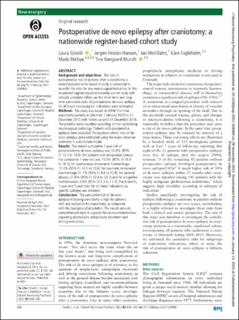| dc.contributor.author | Giraldi, Laura | |
| dc.contributor.author | Vinsløv Hansen, Jørgen | |
| dc.contributor.author | Wohlfahrt, Jan | |
| dc.contributor.author | Fugleholm, Kåre | |
| dc.contributor.author | Melbye, Mads | |
| dc.contributor.author | Munch, Tina Nørgaard | |
| dc.date.accessioned | 2023-01-16T10:47:27Z | |
| dc.date.available | 2023-01-16T10:47:27Z | |
| dc.date.created | 2022-04-01T09:20:58Z | |
| dc.date.issued | 2022 | |
| dc.identifier.citation | Journal of Neurology, Neurosurgery and Psychiatry. 2022, 93 (4), 436-444. | |
| dc.identifier.issn | 0022-3050 | |
| dc.identifier.uri | https://hdl.handle.net/11250/3043669 | |
| dc.description.abstract | Abstract Background and objectives The risks of postoperative risk of epilepsy after a craniotomy is widely believed to be raised. A study is warranted to quantify the risks for any neurosurgical indication. In this unselected register-based nationwide cohort study with virtually complete follow-up, the short-term and long-term cumulative risks of postoperative de novo epilepsy for all major neurosurgical indications were estimated. Methods The study was based on 8948 first-time craniotomy patients in Denmark 1 January 2005 to 31 December 2015 with follow-up until 31 December 2016. The patients were classified according to their underlying neurosurgical pathology. Patients with preoperative epilepsy were excluded. The postcraniotomy risks of de novo epilepsy were estimated using the Aalen-Johansen estimator in a multistate model. Results The overall cumulative 1-year risk of postcraniotomy de novo epilepsy was 13.9% (95% CI 13.2 to 14.6). For patients with intracranial tumour the cumulative 1-year risk was 15.4% (95% CI 14.4 to 16.5), for spontaneous intracranial haemorrhage 11.3% (95% CI 10.1 to 12.6), for traumatic intracranial haemorrhage 11.1% (95% CI 9.6 to 12.9), for cerebral abscess 27.6% (95% CI 22.8 to 33.5) and for congenital malformations 3.8% (95% CI 1.3 to 11.7). The 6-month, 1-year and 5-year risks for all major indications by specific subtypes are provided. Conclusions The cumulative risk of de novo epilepsy following craniotomy is high for patients with any indication for craniotomy, as compared with the background population. The results provide comprehensive data to support future recommendations regarding prophylactic antiepileptic treatment and driving restrictions. | |
| dc.language.iso | eng | |
| dc.title | Postoperative de novo epilepsy after craniotomy: a nationwide register-based cohort study | |
| dc.title.alternative | Postoperative de novo epilepsy after craniotomy: a nationwide register-based cohort study | |
| dc.type | Peer reviewed | |
| dc.type | Journal article | |
| dc.description.version | publishedVersion | |
| dc.source.pagenumber | 436-444 | |
| dc.source.volume | 93 | |
| dc.source.journal | Journal of Neurology, Neurosurgery and Psychiatry | |
| dc.source.issue | 4 | |
| dc.identifier.doi | 10.1136/jnnp-2021-326968 | |
| dc.identifier.cristin | 2014427 | |
| dc.relation.project | Norges forskningsråd: 262700 | |
| cristin.ispublished | true | |
| cristin.fulltext | original | |
| cristin.qualitycode | 2 | |
